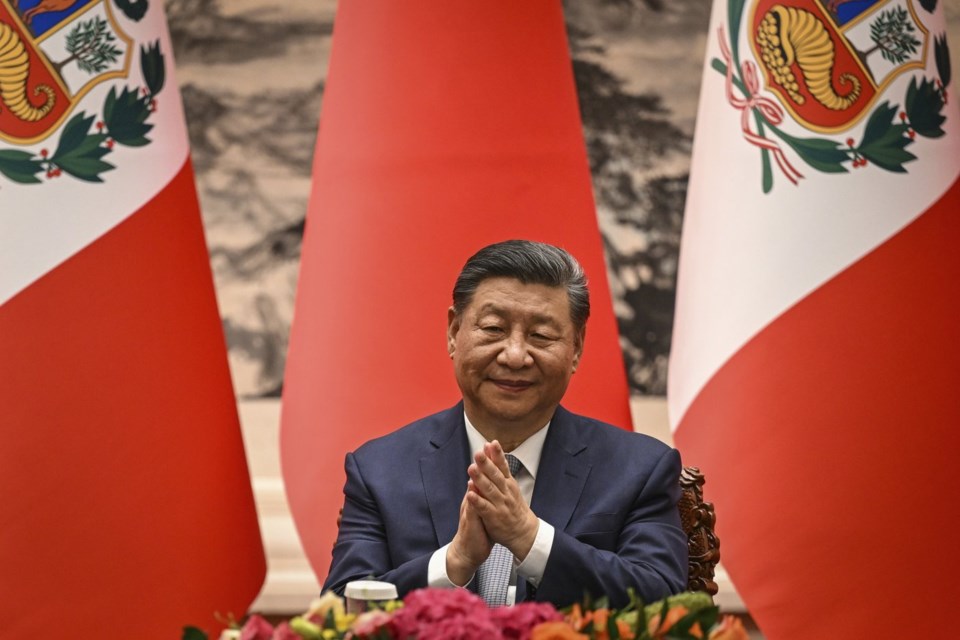CHANCAY, Peru (AP) — On the edge of Peru’s coastal desert, a remote fishing town where a third of all residents have no running water is being transformed into a to cash in on the inexorable rise of .
The megaport of Chancay, a $1.3 billion project majority-owned by the Chinese shipping giant Cosco, is turning this outpost of bobbing fishing boats into an important node of the global economy. inaugurates the port Thursday during the in Peru.
The development — expected to encompass 15 quays and a large industrial park drawing more than $3.5 billion in investment over a decade — has met a skeptical response from impoverished villagers, who say it is depriving them of fishing waters and bringing no economic benefit to locals.
“Our fishing spots no longer exist here. They destroyed them,” said 78-year-old fisherman Julius Caesar — “like the emperor of Rome” — gesturing toward the dockside cranes. “I don't blame the Chinese for trying to mine this place for all it's worth. I blame our government for not protecting us.”
The Peruvian government hopes the port 60 kilometers (37 miles) north of Lima will become a strategic transshipment hub for the region, opening a new line connecting South America to Asia and speeding trade across the Pacific for Peru's blueberries, Brazil's soybeans and Chile's copper, among other exports. Officials cite the port's potential to generate millions of dollars in revenues and turn coastal cities into so-called special economic zones with tax breaks to lure investment.
“We Peruvians are focused primarily on the well-being of Peruvians,” Foreign Minister Elmer Schialer told The Associated Press.
But many of Chancay's 60,000 residents are unconvinced. Fishermen returning to port with smaller catches complain that they have already lost out.
The dredging of the port — which sucked sediment from the seabed to create a shipping channel 17 meters (56 feet) deep — has ruined fish breeding grounds, locals said.
“I’ve been out in the water all day and I’m always needing to venture farther,” said Rafael Ávila, a 28-year-old fisherman with sand in his hair, returning to shore empty-handed and exhausted.
“This used to be enough,” he said, pointing at his painted dinghy. “Now I need a larger, more expensive boat to reach the fish."
To make extra cash, Ávila started offering occasional joyrides to selfie-taking visitors wanting to get a glimpse at the hulking Chinese ships.
With some of the world's largest container ships to berth at Chancay Port in January 2025, residents also fear the arrival of pollution and oil spills. In 2022, a nearby sent thousands of barrels of crude oil spilling into Peru's famously biodiverse waters, killing countless fish and .
Today a glance at the moribund town center, featuring mostly empty seafood restaurants, tells the story of diminished fishing stocks and decimated tourism even without the port being operational.
The port's breakwater changed the currents and destroyed good surfing conditions, locals said, affecting everyone from ice vendors to truckers to restaurant owners. “No to the megaport” is spray-painted on a wall overlooking the waterfront.
“This port is a monster that's come here to screw us,” said 40-year-old Rosa Collantes, cleaning and gutting slimy drum fish on the shore. “People come to the port and they say ‘Wow, tremendous!' but they don't see the reality.”
Port authorities say they're aware of the stark contrast between the sleek modern port and the surrounding village of Chancay, where many live on unpaved roads lined with ragged shacks and littered with trash.
“You cannot build a state-of-the-art port and have a city next to it that has no drinking water, no sewage, a collapsing hospital and no educational centers,” said Mario de las Casas, a manager for Cosco in Chancay, adding that the company had already launched studies to determine how the port could help reduce inequality and spur local growth.
“The port should not be a blemish,” De las Casas said.
Isabel Debre And Franklin Briceño, The Associated Press




